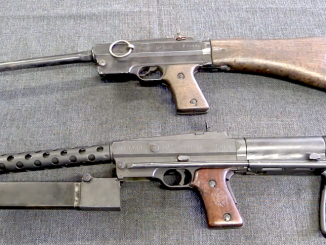Patented in 1896, this is one of several models of unique pocket pistols designed by Paul Brun-Latrige. He was a manager of the Manufrance company located in St. Etienne France, a large mail-order catalog company that produced a wide variety of products. Early versions of this pistol used a ring trigger mechanism and a 5mm cartridge, while this one uses a folding trigger and is chambered for an 8mm round (the same ammunition used in Manufrance’s Gaulois palm pistols, I suspect).
Related Articles

Uncategorized
Forgotten History: The Underground Hell of Fort Vaux

Conversion
Post-War Paris Police MAS 38 Variation

Aircraft MGs

…Damn, that’s an ugly gun. I want one.
“ugly”
Depend on point-of-view. Try to imagine we have 1900 year.
This is novelty, more flat that revolver and without slide moving by cartridge power (now we know that it is safe, but 1900s people might ask: wouldn’t slide escape and hit me in eye?)
I forgot: exist automatic pistol which assembled wrongly can launch slide into face:
Davis Warner Infallible (.32 Auto)
https://en.wikipedia.org/wiki/Davis_Warner_Infallible
When USA entered WW1, import of Schwarzlose 1908 was no longer possible, so Schwarzlose look-a-like utilizing simple blow-back was created, sadly it has design flaw which allowed wrong assembly.
Actually, even if assembled correctly, the Infallible can eject its bolt assembly backward if the retaining screw breaks, which can easily happen on these old pistols. If anyone has an Infallible, I strongly advise against firing it at all.
cheers
eon
Oh the irony of that name …
Advertising trademark,”Blocks the Sear.” If incorrectly assembled,”Slaps your Face.”
Really? I think it looks decent. Kinda reminds of ’50s toy ray guns.
According to Winant in Firearms Curiosa (pp. 83-85, NRA reprint ed.), another French “palm squeezer”, the Rouchouse, worked on this same principle, very like a Japanese Hino-Komura blowforward pistol except without the self-loading action;
http://media.liveauctiongroup.net/i/17982/17333100_1.jpg?v=8D086BFF659DD80
There was also an Italian one, the Tribuzio, patented in 1890 by one Catello Tribuzio of Turin. It was similar in layout to the Rouchouse, and may have worked the same way, although looking at the mechanism it’s hard to tell;
https://p2.liveauctioneers.com/46/29394/11373617_1_l.jpg
Winant states that none of these pistols used any sort of clip-loading, so apparently you had to thumb each round down into the magazine from the top, one at a time. Reloading wouldn’t be a very fast process, but then it’s unlikely that you’d need to. (If the situation were that serious, if you didn’t have another loaded weapon, or the police hadn’t shown up in response to “shots fired”, you’d probably already be dead.)
Incidentally, the way the barrel of the Brun-Latrige draws back inside its outer casing means that said outer casing should act as a fairly efficient flash-hider. Not a bad thing for an encounter after dark.
cheers
eon
“5mm cartridge”
Dimensions: http://www.municion.org/5/5x9Brun.htm
“Palm Lock” pistols.
Indeed,
I bet even that little 5mm cartridge still made the firer’s fingers numb.
Good thing is, may not need trigger return spring.
8mm cartridge is either:
http://www.municion.org/8/8Mitrailleuse.htm
or
http://www.municion.org/protector/protector8.htm
They are interchangeable, but the load seems to have been be different.
Just when I think I have seen it all, here is Ian with something vastly different! It is an interesting firearm, the engraving is super. I am surprised that the grips were not something special. It would be useful as a “contact” weapon as long as you remember to push the magazine cover forward. When in a firefight with it be especially mindful to keep calm. “Push the cover.”
Manually repeating “magazine pistols” such as this,
seem to have been quite a phenomena – if the patents for the genre are any indication.
The reciprocating barrel idea appears to have been fairly common. It certainly wouldn’t surprise me if that was the inspiration for some of the early blow forward auto pistol designs, such as the Manlicher and the Hino-komuro
Here’s an illustration of one with the left grip panel off;
http://www.horstheld.com/Brun-z.jpg
And one of the earlier 5mm ring-trigger version;
http://www.horstheld.com/Brun-y.JPG
cheers
eon
Looking at that ring trigger version, I wonder if the long pull of this action was the inspiration for the version Ian is handling — a little tiring for a single finger, so let’s try a folding one that you can easily pull with two fingers.
By the way, repeated dry firing may damage such an old and valuable gun. I realy appreciate your courage Ian.
So, (from the caption of the second image), actually a 7mm cartridge. Perhaps this one, assuming the dimensions are to scale in the first image you posted:
http://www.municion.org/French/7Galand.htm
I meant this as response to eon.
Great, a manual repeater that can fit in your pocket. And I doubt it poses much of a threat unless the target is already in bad breath range. Seriously, I’d take a pocket revolver or a Roth-Sauer for some real deterrence…
Even today, attempts to come up with “ultimate deep-concealment guns” founder on the basic fact that it’s very had to beat a compact revolver for concealability, reliability, and hitting power.
The overall winner in the non-revolver department was probably the old COP (Compact Off-duty Police) four-barrel “Lancaster-type” double-action in .357 Magnum and .22 WMR. With the even older High Standard Double Derringer in .22 WMR a close second.
It’s ironic that both are basically DA reiterations of designs even older than the Brun-Latrige et al.
cheers
eon
No doubt that non-automatic hand-gun firing same cartridge can be lighter than automatic one, as the last have to have slide of proper mass.
–
But notice that in Europe vest pocket automatic pistols (mainly, but not solely firing .25 Auto cartridge) were popular since 1900s till outbreak of WWII.
There were competition between various fire-arms manufacture, some try to build automatic pistol as light as possible for example Mann:
http://unblinkingeye.com/Guns/Mann/mann.html
(notice solution which I would call “anti-Revelli groove” for retarding case ejection)
Click here: http://www.vestpockets.bauli.at/archiv/archiv.htm
too see part of uncountable plethora of European vest pocket automatic pistols
“Great, a manual repeater that can fit in your pocket.”
See Semmerling LM-4 (firing .45 ACP) for modern manual repeating pocket pistol:
http://www.imfdb.org/wiki/Semmerling_LM-4
Reminds me of a fancy captive bolt gun at first glance.
I thought: Staple Gun. But it is nicely done.
I am curious about whether/how this locked up at the point of firing.
The commentary section is always interesting yet annoying at the same time. The concept of a truly compact, low-key purely defensive item seems to be particularly difficult for the inexperienced-in-real-life to grasp.
The COP is mentioned in .357 Magnum, as well as the Semmerling in .45 ACP, and also the Hi-Standard Double Derringer in .22/.22 Magnum. The COP is out of the running because it fails on too many levels. If the proponent’s knowledge is based on pictures out of a book, it’s not obvious that it’s not only bigger and heavier than a S&W 5-shooter revolver, but current collecter’s valuation would make you unwilling to even take it out of the house. Actually firing a .357 Magnum cartridge from a COP (which I have done,) generates so much sound, fury, and recoil that it becomes difficult to intice the user to fire a second round. For all of that, the minimal short barrel drops the bullet performance to an equally minimal level. However, on the plus side, since the flamboyant fireball generated is spectacular, once the collateral small fires are extinguished, most find the spectacle entertaining. Most of the above commentary applies equally to the Semmerling, except the Semmerling requires manipulation between shots, not a positive attribute in a “last ditch holdout piece” and yet still bigger and heavier than the pictures make it look.
Likely the the real problems for actual use of these two, aside from size and weight is they’re so unpleasant to shoot, the user will just plain not practice to a reasonable level of competence
More practical, believe it or not, is the Double-Derringer in .22 Magnum. I’ve owned one for more than 25 plus years and it’s lived in my hip-pocket for most of that time. It’s small, generates a respectable wallup on the receiving end, is so low-key I can go to the bank without causing a ruckus, and it’s so economical to practice with one can actually get rather good at it. An over/under pair of barrels are quite rigid and capable of surprising accuracy…which is to say, accurate enough out to 10 to 12 meters/30 to 35 feet) or so. It also generates a respectable fireball of entertainment value.
All that said, in all the years, I’ve only had call to use it one time…
And that time, I never got it out of my hip pocket.
The scene is winter (short days, long nights) and I am alone in my retail store closing up for the night. It’s just me and my elderly, crippled Lakeland Terrier.
The doors bell rings, I turn around to see the walking personification of evil walk through the door. No joke, this is a bad, bad person, eminating horrible intent with every step. Such an Aura.
No dialogue, neither of us spoke, I just went for the Derringer.
And the elderly, crippled terrier came alive, morphed into Were-Lakeland, made a SNARLING advance on Mr. Evil and prepared to climb him like a tree biting off chunks all the way.
Mr. Evil retreated so violently he actually bounced off the one-way door trying to exit.
We, myself, the Derringer, and 16 pounds of Were-Lakeland let him go. We both had chicken dinner that night.
I still have the High Standard
He got a whole can of chicken.
Good dog.
“It also generates a respectable fireball of entertainment value.”
Because .22 WMR is rifle cartridge, powder charge optimized for longer barrel.
“Double-Derringer in .22 Magnum”
I would say that for extreme short barrel .25 Auto is best cartridge (from small cartridges still alive), because it was from scratch designed for such barrels. If you compare ballistic of .25 Auto and .22 WMR for short barrel:
http://www.ballisticsbytheinch.com/calibers.html
they are quite close, for example – for 3″ barrel:
.25 Auto: 50 gr FMJ @ 903 fps, give momentum 45150
.22 WMR: 45 gr @ 1049 fps, give momentum 47205
Does this thing rip off your trigger finger or is there some kind of locking mechanism.
By what I can see from the video, the force applied by the hand/triggerfinger, seems to be all what keeps the system closed while shooting.
British Patent 13,787 dated 17th July 1894 was granted to AJ Boult, who appears to have been an agent for P Brun-Latrige. The illustration shows the ring trigger version without the cocking indicator on the striker. The magazine spring is not in the usual position under the follower. The follower has an extension working through a slot onto a coil spring in a parallel vertical hole in the backstrap.
P Brun-Latrige had several other British patents granted between 1888 to 1894, mainly to do with break or sliding action shotguns.